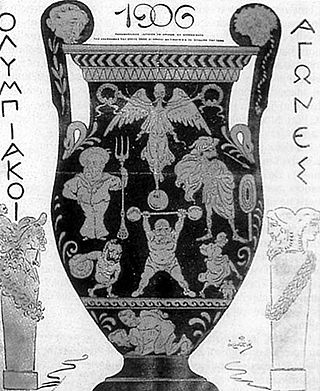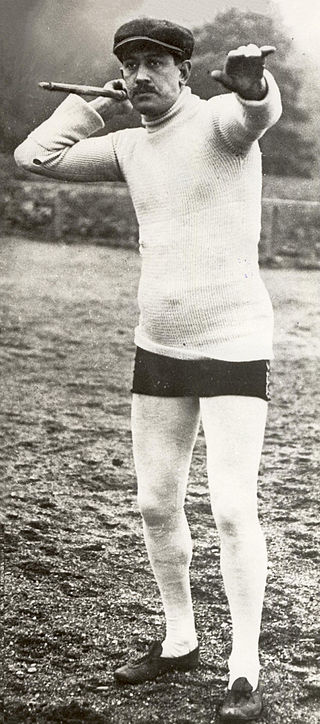At the 1906 Summer Olympics in Athens, a tug of war event was contested. [1] Now called the Intercalated Games, the 1906 Games are no longer considered as an official Olympic Games by the International Olympic Committee.

The 1906 Intercalated Games or 1906 Olympic Games, held from 22 April 1906 to 2 May 1906, was an international multi-sport event that was celebrated in Athens, Greece. They were at the time considered to be Olympic Games and were referred to as the "Second International Olympic Games in Athens" by the International Olympic Committee (IOC). However, the medals that were distributed to the participants during these games were later not officially recognised by the IOC and are not displayed with the collection of Olympic medals at the Olympic Museum in Lausanne, Switzerland.
At the 1906 Summer Olympics in Athens, four gymnastics events were contested, all for men only. Now called the Intercalated Games, the 1906 Games are no longer considered as an official Olympic Games by the International Olympic Committee.
At the 1906 Summer Olympics, only four swimming events were contested. Now called the Intercalated Games, the 1906 Games are no longer considered as an official Olympic Games by the International Olympic Committee.

Eric Otto Valdemar Lemming was a Swedish track and field athlete who competed at the 1900, 1906, 1908 and 1912 Olympics in a wide variety of events, which mostly involved throwing and jumping. He had his best results in the javelin throw, which he won at the 1906–1912 Games, and in which he set multiple world records between 1899 and 1912. His last record, measured at 62.32 m, was ratified by the International Association of Athletics Federations as the first official world record.
Erik Gustaf Granfelt was a Swedish gymnast who competed at the 1908 Summer Olympics. He was part of the Swedish team, which was able to win the gold medal in the gymnastics men's team event in 1908.

Torsten Oswald Magnus Holmberg was a Swedish gymnast and tug of war competitor who participated in the 1908 Summer Olympics and in the 1912 Summer Olympics.

Karl Axel Patrik Norling was a Swedish gymnast, diver, and tug of war competitor who participated in the 1906 Intercalated Games and 1908 and 1912 Summer Olympics. He won a bronze medal in the tug of war in 1906, as well as two gold medals with the Swedish gymnastics team, in 1908 and 1912, alongside his younger brother Daniel.
Wilhelm "Willy" Dörr was a German track and field athlete and tug of war competitor who competed in the 1906 Intercalated Games. He was born and died in Frankfurt am Main. In 1906, he was part of the German team which won the gold medal in the tug of war competition. In the ancient pentathlon contest he finished 16th and he also participated in the discus throw event but his result is unknown.
Vassilios Psachos, also Psakhos; 1877–?) was a Greek tug of war athlete from Zarouchleika, Patras. He was the younger brother of Georgios Psachos.
Georgios Psachos was a Greek tug of war athlete from Zarouchleika, Patras. He was the brother of Vassilios Psachos.
Konstantinos Lazaros was a Greek tug of war athlete.

Johan Gustaf Anton Gustafsson was a Swedish athlete who won a bronze medal in the tug of war competition at the 1906 Intercalated Games. Gustafsson was a Swedish weightlifting champion in 1905–1907, and it is unclear why he did not compete in weightlifting at the 1906 Games.

The discus throw is one of four track and field throwing events held at the Summer Olympics. The men's discus throw has been present on the Olympic athletics programme since 1896. The women's event was first contested at the 1928 Olympics, being one of the five athletics events in the inaugural Olympic women's programme.
Bruno Julius Wagner was a German athlete and gymnast who competed for Germany and Switzerland in the Olympic Games.

Pistol dueling was a sport at the 1906 Intercalated Games and 1908 Olympics.